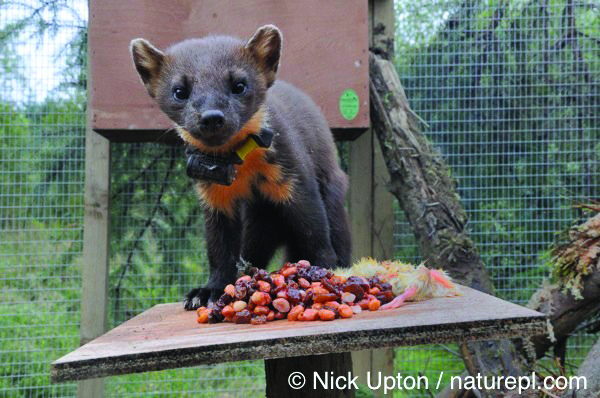In the ancient wildwoods that once blanketed much of Britain, the pine marten was one of our most common carnivores, thriving amongst the diversity of trees and shrubs that offered a year round supply of food and snug tree holes in which to den.
Pine marten numbers declined dramatically during the 19th and early 20th century as a result of the combined impact of continued habitat loss and an increase in predator control associated with the growth in Victorian game shooting estates. Whilst the pine marten population in Scotland is recovering and expanding, the marten population in England and Wales had been showing no sign of recovery and the likely outcome would have been extinction. It was clear that intervention was needed to restore viable populations of this native mammal south of the Scottish border.
Although very rare, pine martens were still surviving in low numbers in parts of the Cambrian Mountains, Carmarthenshire and Snowdonia. With this evidence of pine martens present in some areas, reinforcement was considered a possibility, focusing on those areas within the marten’s natural range where habitat and other conditions are suitable. ‘Reinforcement’ means releasing individuals into an existing population, to increase population size and genetic diversity in order to improve population viability.
A feasibility study was carried out to identify areas in Wales with high habitat suitability for pine martens. Following extensive field surveys, engagement with local communities and stakeholders, and with relevant licences granted, a population reinforcement was carried out.
Between 2015 and 2017, 51 pine martens were captured in Scotland, in areas where there is a healthy pine marten population, under licence from Scottish Natural Heritage. These animals were translocated and released in forestry in mid-Wales. The martens were kept in release pens for a few days once they arrived in Wales to allow them to acclimatise to their new surroundings and allow us to monitor them remotely via camera trap. They were given a variety of food similar to their natural diet.
The translocated pine martens have become established and breeding has been recorded every year since the translocation began.

A pine marten, translocated from Scotland to mid-Wales, in a pre-release pen ©Nick Upton
Watch Wild again in Wales, produced in January 2020.

‘Having searched high and low for years for pine martens in Wales and without success, it is so heartening to know that these animals are back in their former haunts once more. The work the VWT is doing is absolutely brilliant.’
Iolo Williams, naturalist, TV presenter and patron of the Pine Marten Recovery Project
Northern England
The pine marten population in Scotland is recovering and expanding and pine martens have begun to spread over the English border and re-colonise areas of Northumberland and Cumbria. The rate and success of this re-colonisation will depend on the availability of suitable habitat and the influence of anthropogenic factors, such as mortality on roads.
Vincent Wildlife Trust helped to pave the way for the recovery of the pine marten in northern England through our Back from the Brink project, between 2017 and 2020. The project monitored the re-colonisation of pine martens in Northumberland and Cumbria with help from a network of volunteers, installed artificial den boxes to provide resting and breeding sites for pine martens, and raised awareness of the species.
While parts of northern England are being slowly re-colonised by the southward expansion of the Scottish pine marten population, pine martens are unlikely to re-colonise southern and central England naturally. As a result, reintroductions are likely to be the best solution if we are to restore pine martens to southern and central England.
Forest of Dean
In 2016, VWT began a collaborative project led by Gloucestershire Wildlife Trust and Forestry England to embark on the reintroduction of the pine marten to the Forest of Dean and Wye Valley in Gloucestershire. Following a period of research and completion of a feasibility study, the translocation of pine martens to the forest began with 18 pine martens released in autumn 2019 and a further 17 martens released in autumn 2021. See further information on the Gloucestershire Wildlife Trust website.
Vincent Wildlife Trust’s work in Scotland has focused on monitoring the recovery and range expansion of the pine marten population. The Trust undertook the first national pine marten survey of Scotland, England and Wales in the early 1980s. In 2012, the Trust completed a pine marten expansion zone survey in collaboration with Scottish Natural Heritage, to provide up-to-date information on current pine marten distribution. The survey confirmed that the pine marten population has continued to expand its range south and east of the Highlands and has re-colonised many parts of its former range in central and eastern Scotland.
This work was subsequently followed in 2013 by a distribution survey of southern Scotland. This survey found that pine martens are now present in parts of the Scottish borders and other areas south of the Central Belt where they have been absent for almost 200 years.
The reports of both surveys can be downloaded for free: 2012 report and 2013 report.

People’s Trust for Endangered Species (PTES) is a UK conservation charity ensuring a future for endangered species throughout the world. Working to protect some of our most threatened wildlife species and habitats. We are delighted to have PTES as our major funder of this project.

Chester Zoo is a registered conservation and education charity that supports projects around the world. Through its wildlife conservation campaign, Act for Wildlife, the zoo is helping to save highly threatened species around the world from extinction.We are delighted to have Chester Zoo on board as partners in the project, and the expertise of the zoo’s staff in animal husbandry and welfare is a very welcome addition to the project. A team from the Zoo have built bespoke release pens for the pine martens and they joined us to set up the pens at the release sites.

Woodland Trust is the UK’s leading charity championing native woods and trees. It has over 400,000 supporters. Established in 1972, the Woodland Trust now has over 1,000 woods in its care covering approximately 20,000 hectares (50,000 acres).We are delighted to have the Woodland Trust on board as partners in the project, their woodland management and landscape knowledge is a very welcome addition to the project.
![]()
Wildlife Vets International (WVI) is a British registered charity, created in 2004 by a group of highly experienced zoo and wildlife vets to give conservation workers the specialist veterinary support and skills they need.
In addition to the above mentioned partners, we have received help in-kind from a number of other organisations, including Exeter University, Forestry Commission Scotland, Scottish Natural Heritage and Natural Resources Wales, for which we are immensely grateful.
A new era in pine marten conservation
Although the species has been slowly recovering, these new pine marten populations are still small and isolated and need the support of local communities to ensure their long-term survival and range expansion across the counties.
Martens on the Move is a new project, funded by The National Lottery Heritage Fund, working with stakeholders and local communities across twelve counties in Scotland, England and Wales to ensure that pine Martens can thrive as they expand into new areas.

Photo: ©James A. Moore